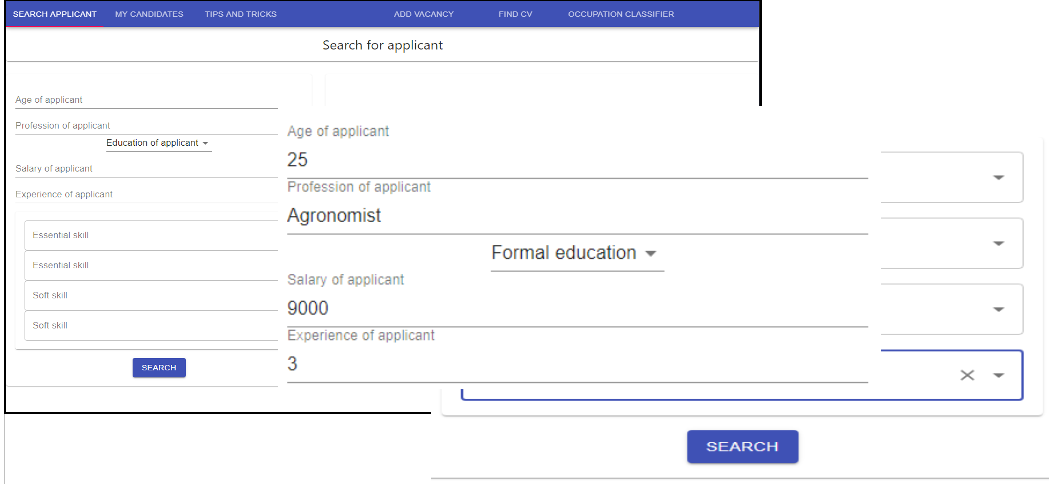The general architecture of AdvisOnt contains the following components (Fig.1): applicant – person who needs in some work in agricultural domain and has a set of relevant competencies and skills; employer – person or organization who needs in employees for execution of some task or work on some position; providers of learning services – organizations that propose various (formal, non-formal and informal) learning means for expansion of personal competencies; advisor – expert specialized in agricultural domain of fixer region that can use domain knowledge for refinement of mutual interests of employers and applicants and provides advising services if applicant qualification needs in additional learning according to employer demands.
Fig. 1. General architecture of agro-advisory system AdvisOnt
This general architecture of agro-advisory system AdvisOnt defines the main relations and data flows between AdvisOnt services (Table 1) and external informational resources. In this work we don`t consider in details the functions and software realization of these services that are usual for agro-advisory systems but analyse their modification provided by validation of outcomes of non-formal and informal learning (by formalized NILO processing).
Table 1. AdvisOnt services
|
Service |
Functionality |
Input |
Output |
|
|
user profile formalization service |
transforms basic information about user into representation with fixed structure and data types |
User profile, NILO |
Formalized user profile, formalized NILO |
|
|
vacancy formalization service |
transforms information about the needs of the employer and the requirements for employees into representation with fixed structure and data types |
Vacancy |
Formalized vacancy, the set of competences |
|
|
competency analysis service |
matches properties of finite sets of competencies for information objects from various classes in consideration of competence hierarchy |
Formalized user profile, formalized NILO |
the set of competences |
|
|
vacancy and resume matching service |
matches the needs of the employer and the capabilities of the employee represented by the finite sets of competences |
The set of competences, formalized user profiles, formalized vacancies |
The set of formalized vacancies |
|
|
educational resources search service |
provides semantic matching of educational resources with formalized user profile and capabilities of the employee represented by the finite sets of competences (agricultural advisory domain ontologies are used as a knowledge sources in this matching). |
The set of competences, formalized user profiles, formalized vacancies, formalized NILO |
The set of educational resources |
AdvisOnt services are oriented on use of external knowledge represented by ontologies provided by various pertinent independent sources. This set of ontologies can be changed according to task without changes of AdvisOnt architecture.
Table 2. Use of external ontologies by AdvisOnt services
|
Service |
Input knowledge |
|
|
user profile formalization service |
User profile ontology |
|
|
vacancy formalization service |
ESCO, competence ontology, agroadvisory domain ontology |
|
|
competency analysis service |
ESCO, competence ontology, agroadvisory domain ontology |
|
|
vacancy and resume matching service |
Domain ontologies, linguistik knowledge bases |
|
|
educational resources search service |
MOOC ontology |
AdvisOnt obtains information from RDF-storage through SPARQL query language requests. SPARQL receives application requirements in the form of a query and returns this information in the form of a set of links or as an RDF graph. Use of connectors speeds up the work with the storage. GraphDB connectors provide fast search (simple and faceted) that typically implemented by external component or service such as Lucene. When this connector receives the text in it’s field it executes search for defined labels and returns reference to the class corresponds to the specified query. The query consists of prefixes to access a specific part of the ontology, namely the connectors, without touching the main part. Thus is more secure, because the application haven’t direct access to the ontology.
One of the benefits of using GraphDB connectors is automatic updating of data from GraphDB repositories. Connectors provide entity-level synchronization, where an entity is defined as something with unique identifier (URI) and with the set of properties and property values. Connectors support of the property chains (sequence of triples where the object of each triple is the subject of the next triple).
AdvisOnt users interact with information from the RDF repository by the Web server that processes requests to the repository and analyses the request results. This server developed with use of PHP and PHP Laravel framework that speeds up the development process: PHP Laravel framework provides increased security and readiness to install plug-ins and libraries and has such features as RESTful-routing, caching, user management and authentication.
User interface of AdvisOnt is developed on base of React framework that allows to create large web applications with data that changes over time without page reloading. The React framework has the following advantages: speed, simplicity, scalability. The React concept on the user interface consists of separate self-sufficient components that are quite simple to maintain and extend. User interface is realized as functional panel and working window. An example in fig. 2 shows a working form for search of agro-specialists by parameters of formalized vacancy: the name of the profession, age, salary, basic and additional skills. Names of search conditions are defined by appropriate ontology.
Fig. 2. Agricultural advisory system user request form to search for a job seeker
Search results gives out the list of applicants relevant to the values of specified parameters. Information about competencies of applicants is extracted from their formalized resumes. Such formalization is provided by appropriate аgricultural advisory service of AdvisOnt and consists in matching of non-formal descriptions of user skills and knowledge with elements of competence ontology.


